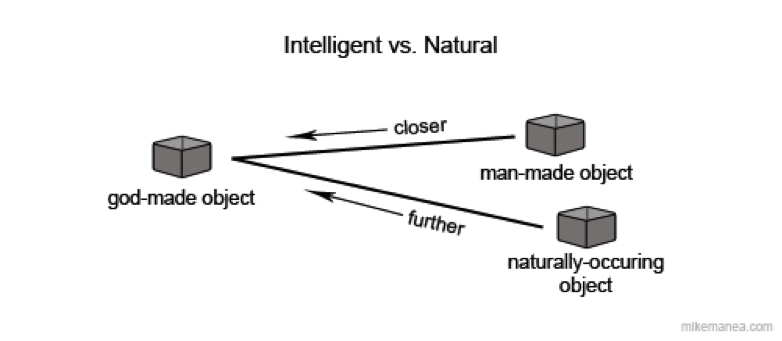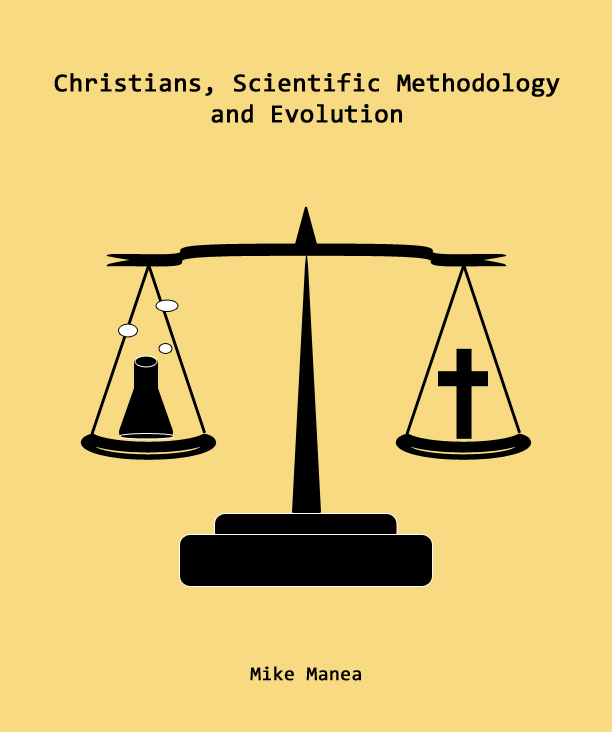An Alternative Theory
 So far in this series we’ve established that
So far in this series we’ve established that
- science works under an assumption of naturalism;
- the lack of alternative models makes evolutionary theory seem more certain than it is; and
- the alternative models proposed so far by Creationists have not been very successful.
Now let’s elaborate on the question of how to study a supernatural phenomenon like Creation using methodological naturalism.
Even when something is created supernaturally, it still ends up natural at some point and is therefore subject to science. Moreover, something created supernaturally should have more in common with something that was created by an intelligent natural entity as opposed to something that developed entirely through inanimate natural causes.
I am going to use a very simplistic illustration to get this point across. Suppose a little girl is walking on a beach after a storm and finds a mound of sand sculpted by the wind and waves. She decides to build another mound just like it. And let’s suppose that after the girl leaves, some supernatural entity comes along and supernaturally creates a third mound next to the other two. If a scientist finds all three mounds and decides to research their origin, what would that research reveal?
Chances are that unless this supernatural entity used another storm to build that third mound, it will have more in common with the one built by the little girl than with the one that resulted from natural causes.

Now this does not mean I am making a definitive claim here; there is no way to know for sure if that would be the case. I am just saying that overall this would be a safe guess to make. And this could provide a rationale for us to look into the possibility of natural intelligent involvement in the development of life on earth.
Searching for Intelligent Interference
Human bioengineers are already able to tamper with the genetics of various organisms, and it is likely that they will eventually be able to produce organisms with entirely new features. Thus, beside the Darwinian mechanism for new genetic information resulting from mutations and natural selection, another valid mechanism is genetic engineering.
In essence, the way to study a supernatural hypothesis like Creation using methodological naturalism is to convert it to a natural hypothesis by assuming that the creation process was natural. In the case of organisms on earth, this would imply that an intelligent, technologically advanced, extraterrestrial entity used bioengineering to interfere with and direct the evolutionary process to some degree. By postulating an alien creator instead of a supernatural one, supernatural concepts like Creation can be looked at using methodological naturalism.
When I discuss this with atheist biologists, I explain it with a series of questions:
- Do you believe that one day science will advance far enough for us to be able to tamper with the genetic code of organisms and significantly alter the way those organisms and their offspring look?
- Do you think we will be able to bioengineer entirely new organs or features?
- What about entirely new organisms?
- If by that time space travel significantly improves and we discover a planet that is populated with very simple life forms, will we be able to use those life forms to bioengineer new, more complex ones, appropriate for the conditions on that planet?
If so, let’s just suppose that we do this and then leave the planet. Millions of years down the line, these life forms evolve to the point of intelligence, something that would not have happened had we not interfered. How would their scientists study the development of life on that planet? Would they have to assume it was entirely through evolution even though that’s not what actually happened?
If we can devise a way to study the possibility of intelligent interference in this hypothetical scenario, then we can apply that same methodology to life on earth. Again, I’m not saying here that I believe life on earth was created by aliens but simply that this is a way to formulate a naturalistic hypothesis addressing the possibility of intelligent interference.
I have on occasion run into evolution supporters who claimed that it would not be possible to come up with testable predictions if intelligent interference was postulated, even if this was done by a natural entity. But if that were true, that would be a much bigger problem for them than for us. After all, they are saying that it is necessary to assume evolution even in a situation where intelligent interference definitely happened (as in this hypothetical scenario). So what does that tell us about scientific assumptions regarding life on earth?
However, there is no reason to think that such a model would be unable to make testable predictions; after all, scientists study situations where they postulate intelligent interference (by humans) all the time.
In conclusion, while the scientific process is very effective at studying nature, it lacks the ability to look into the possibility of supernatural involvement. Therefore, in order to study this question, we have to find roundabout ways to do it, like the process described above. We need to look for ways to convert the supernatural aspects into a natural hypothesis that can make testable predictions.
What an Alternative Model Will Accomplish
Let’s briefly discuss what will happen if we manage to introduce this alternative model into science.
First, this will not prove that God exists or that the Bible is correct. But there will be a theory for the development of life on earth that is closer to the Bible than evolution, and this would make a huge difference for us.
Second, this model will make it possible for scientists from multiple Christian denominations and from other theistic religions, as well as atheists who are interested in the possibility of extraterrestrial involvement, to work together. This will greatly reduce the manpower and funding deficits that Creationists usually face.
Third, this alternative model will reduce the bias faced by scientists working under the standard model. The evolutionary model has strict requirements regarding geologic time, the fossil record, etc., and anomalies tend to be ignored or reinterpreted in light of these requirements. The new model will be much more flexible in many respects.
And finally, evolution supporters will no longer be able to take for granted things like the evolution of biological machines. Since an alternative mechanism exists, they will need to provide concrete evidence that evolution can produce these structures as well.
How to Begin
I believe that by following this approach an alternative model can be introduced in five years or less. This does not mean that the theory of evolution would be displaced in five years, but simply that a sufficiently well-framed hypothesis could be formulated and sufficient data gathered to have something that can be presented to the scientific community and the public. This will allow Creation scientists to publish papers in scientific journals and to accumulate evidence toward this model. It will also provide enough of a structure for other scientists to come on board as well. If so, it will be more than has ever been accomplished before by any anti-evolution group.
My vision is for a small team of scientists to come together: scientists who have research experience; who have published papers in reputable journals; who have a background in biology, genetics, and related fields; and who are very familiar with evolutionary theory. The majority of the scientists’ time initially will be spent
- looking over the current theory to determine where exactly an alternative theory will best fit,
- formulating an alternative hypothesis that makes testable predictions, and
- doing some initial research to see if the data lines up with expectations in support of this model.
While much of the initial work will be theoretical, there will also need to be interaction with the scientific community and possibly the media in order to establish the validity of this model. Also, a small marketing team should work on developing effective ways to introduce this new idea to the public.
What next?
At this point in time what would be most beneficial is to promote dialogue on this topic. Creation scientists have tried many different approaches over the past century with little success. If there is an approach that actually stands a chance of succeeding, we should at least discuss it further. Please add your thoughts below and consider sharing this article with anyone you know who has a background or interest in science and biology.
